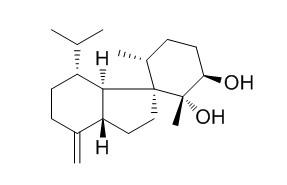Gopherenediol
Gopherenediol shows weak antifeedant activity.
Inquire / Order:
manager@chemfaces.com
Technical Inquiries:
service@chemfaces.com
Tel:
+86-27-84237783
Fax:
+86-27-84254680
Address:
1 Building, No. 83, CheCheng Rd., Wuhan Economic and Technological Development Zone, Wuhan, Hubei 430056, PRC
Providing storage is as stated on the product vial and the vial is kept tightly sealed, the product can be stored for up to
24 months(2-8C).
Wherever possible, you should prepare and use solutions on the same day. However, if you need to make up stock solutions in advance, we recommend that you store the solution as aliquots in tightly sealed vials at -20C. Generally, these will be useable for up to two weeks. Before use, and prior to opening the vial we recommend that you allow your product to equilibrate to room temperature for at least 1 hour.
Need more advice on solubility, usage and handling? Please email to: service@chemfaces.com
The packaging of the product may have turned upside down during transportation, resulting in the natural compounds adhering to the neck or cap of the vial. take the vial out of its packaging and gently shake to let the compounds fall to the bottom of the vial. for liquid products, centrifuge at 200-500 RPM to gather the liquid at the bottom of the vial. try to avoid loss or contamination during handling.
J Ethnopharmacol.2019, 236:31-41
J Plant Biochem.Biotech.2024, 33:353-366.
Front Nutr.2023, 10:1168095.
Journal of Molecular Liquids2022, 364:120062.
BMC Plant Biol.2022, 22(1):128.
Plant Physiol Biochem.2023, 201:107795.
Nature Ecology & Evolution2020, doi: 10.1038
Int J Med Sci.2021, 18(10):2155-2161.
Environ Toxicol.2021, 36(9):1848-1856.
Appl. Sci.2024, 14(12), 5280.
Related and Featured Products
Springer US,2005 :409-416
Cottontails and gopherweed: Anti-feeding compounds from a spurge[Reference:
WebLink]
Mammalian herbivores nearly never attack gopherweed, Euphorbia lathyris (Euphorbiaceae). To find the chemical principle responsible for the deterrent effect, we field-tested plant extracts in response-guided bioassays for antifeedant activity.
METHODS AND RESULTS:
We treated winter-dormant apple twigs with extract solutions and presented them to free-ranging eastern cottontails, Sylvilagus floridanus, at 3 different home ranges in Upstate New York during late winter. Extracts from all plant parts reduced feeding, measured as twig tips cut and amount of bark removed, but root extracts were most active. The bioassay led to isolation of putative antifeedant compounds from the root extract, a series of long-chain alkyl ferulates and Gopherenediol, a new diterpenoid.
CONCLUSIONS:
Bioassay of docosanyl ferulate and Gopherenediol demonstrated weak antifeedant activity. The bioassays are continuing.



